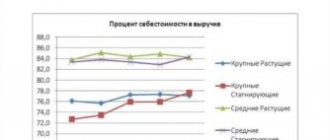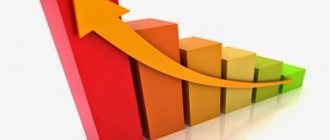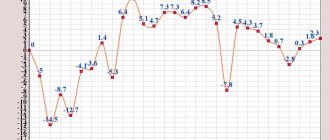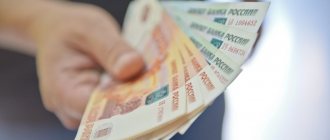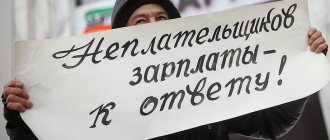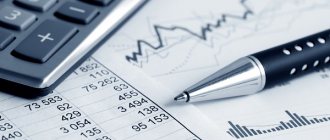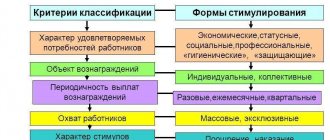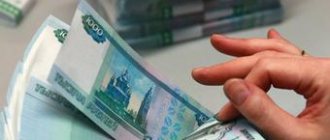Cost is the cost of production: the amount spent on producing a product and promoting it on the market. The markup depends on the cost: how much above the production price must be received upon sale for the enterprise to be financially profitable for its owners? The size of the markup is limited, because the cost of the product must be related to the average price on the market.
It is not difficult to calculate how much profit an enterprise will receive if the cost of one ballpoint pen is, say, 10 rubles, and the average market price of this product is 100 rubles. And if at the same market price the cost is 90 rubles? Therefore, manufacturers strive to reduce the cost of creating goods.
Start-up businesses need to gain a foothold in the market and achieve self-sufficiency as quickly as possible. To do this, we have to fight not only for the quality of goods, but also for their attractive retail and wholesale prices and low cost. Companies that have been on the market for a long time strive to maintain their positions; for this they also have to optimize production costs.
Enterprises have to fight not only for the quality of goods, but also for their attractive retail and wholesale prices and low costs.
“Consumer cooperatives that produce goods are no less interested in reducing their costs than commercial organizations. The goal of a consumer cooperative is to provide participants with quality goods and services on favorable terms. What favorable conditions can we talk about if the final cost of goods turns out to be higher than the market price due to high production costs?”
General concept of cost
In every economics textbook you can find a varied interpretation of the term “cost”. But no matter how the definition sounds, its essence does not change.
The cost of production is the sum of all costs incurred by the enterprise for the manufacture of goods and their subsequent sale.
Costs are understood as expenses associated with the purchase of raw materials and materials necessary for production, remuneration of workers, transportation, storage and sale of finished products.
At first glance, it may seem that calculating the cost of production is quite simple, but this is not entirely true. At every enterprise, such an important process is entrusted only to qualified accountants.
It is necessary to calculate the cost of goods regularly. This is often done at certain intervals. Every quarter, 6 and 12 months.
If you decide to open your own business and are thinking about how to make money, then without these calculations it is impossible to calculate whether the business is paying off or not, whether there is a need to expand production and how successful your business is.
Planned cost
The amount of all costs of an enterprise is determined by standard indicators or by directly transferring them to products.
According to the definition, planned cost is an indicator of the value of the volume of production during its production. The calculation is carried out both for total output and per unit of goods.
Planned cost indicators are typical for the manufacturing industry, but they also occur in the accounting of trading enterprises. The spent part of the money that supports production processes is also included in the price of the finished product.
Planned calculation of product costs is necessary to determine the feasibility of producing goods. Based on this indicator, the management of the enterprise makes a decision to change the course of activity and work with contractors.
Types and types of cost
Before you start calculating production costs, you need to study what types and types it is divided into.
Cost can be of 2 types:
- Full or average - includes absolutely all expenses of the enterprise. All costs associated with the purchase of equipment, tools, materials, transportation of goods, etc. are taken into account. The indicator is averaged;
- Limit – depends on the quantity of products produced and reflects the cost of all additional manufactured units of goods. Thanks to the obtained value, it is possible to calculate the efficiency of further expansion of production.
The cost is also divided into several types:
- Shop cost - consists of the costs of all enterprise structures whose activities are aimed at producing new products;
- Production cost – represents the sum of shop cost, target and general expenses;
- Full cost - includes production costs and costs associated with the sale of finished products;
- Indirect or general business costs - consists of costs that are not directly related to the production process. These are management expenses.
Cost can be actual or standard.
When calculating the actual cost, real data is taken, i.e. Based on actual costs, the price of the product is formed. It is very inconvenient to make such a calculation, because Often it is necessary to find out the cost of a product before it is sold. The profitability of the business depends on this.
When calculating standard cost, data is taken in accordance with production standards. Thanks to this, it is possible to strictly control the consumption of materials, which minimizes the occurrence of unjustified costs.
Actual cost
The indicator characterizing the actual funds spent on the production of a unit of goods is called its actual cost. Material, production, financial and other costs are recorded in accounting.
Planned and actual costs are different values. Planning occurs at the beginning of the annual or quarterly period, but during the production process, the amount of costs and the cost of materials may change.
The actual indicator is the amount of costs for the acquisition of inventories (MPI). Refundable taxes, such as value added tax (VAT), are not taken into account.
Product cost structure
All enterprises that produce products or provide services are different from each other. For example , the technological processes of an ice cream manufacturing plant and a soft toy sewing factory are completely different.
Therefore, each production individually calculates the cost of finished products. This becomes possible thanks to a flexible cost structure.
Cost is the amount of expenses. They can be divided into the following categories:
- Expenses on raw materials and materials necessary for production;
- Energy costs. Some industries take into account the costs associated with using a certain type of fuel;
- Costs of machinery and equipment through which production is carried out;
- Payment of wages to employees. This item also includes payments related to taxes and social services. payments;
- Production expenses (premises rental, advertising campaigns, etc.);
- Expenses for social events;
- Depreciation deductions;
- Administrative costs;
- Payment for services of third parties.
All costs and expenses are percentages. Thanks to this, it is easier for the head of the enterprise to find the “weak” aspects of production.
The cost price is not constant. It is influenced by factors such as:
- Inflation;
- Loan rates (if the company has any);
- Geographical location of production;
- Number of competitors;
- Use of modern equipment, etc.
In order for the enterprise not to go bankrupt, it is necessary to timely calculate the cost of the product.
Costing
The calculation of planned cost begins with the preparation of cost estimates and costing. The indicator characterizes the planned average value. The basis for identifying the amount is progressive cost standards for production, consumables, fuel, energy and others.
Planned costing begins with collecting information about previous expenses and the rates of consumption of materials and raw materials. The final result depends on many factors:
- Production waste.
- Technical characteristics of the equipment.
- Purchase cost of raw materials and additional components.
- Production time and labor costs.
Thanks to the calculation, the management of the enterprise receives a complete picture of the cost of each individual type of product.
An example of calculation for the total production volume and each type of product is presented below.
According to the example presented, the cost of 1 stool will be 1119.45 rubles, and the cost of a cabinet will be 2217 rubles.
At mass production enterprises, cost calculation occurs in stages. In each of the workshops, the products receive an additional markup and come out with a certain cost. This is how a gradual increase in the value of a product is formed during the production process.
This method of determining cost helps to make a reliable cost analysis. For example, in the production of fabrics, the spinning shop determines the costs of making cloth, and the dyeing department writes off its costs to the finished fabric. Based on the results of the formation of the cost of the canvas, the enterprise’s economists can identify at which point in production the costs can be optimized.
The method of incremental costing is relevant for the production of large volumes at large enterprises.
It is better to determine the planned cost of production using cost estimates for a new type of product. The basis for calculations are projects and standards for individual cost estimates. Planned unit costing is a short-term planning system. It is necessary so that the enterprise can determine the stages of further development.
Reported costs help determine the amount of the actual cost of production. It may consist of the following costs:
- Raw materials.
- Waste production.
- Energy and fuel for technical support.
- Workers' wages.
- Additional wages.
- Social deductions.
- Equipment depreciation.
- General running costs.
- Production and non-production costs.
- Other expenses.
In factories with a large area, transport costs may be included in the cost. Depending on the specifics of the industry, there may be other costs: purchase of semi-finished products, additional units, etc.
Calculation of actual cost = Product balance at the beginning of the cycle (work in progress) + Costs incurred during the month - Costs for setting up the production process - Remaining at the end of the cycle - Defects.
Formation of production costs
When calculating production costs, the costs required to produce products are summed up. This indicator does not take into account the costs of selling products.
The formation of the cost price at the enterprise occurs before the products are sold, because the price of the product depends on the value of this indicator.
It can be calculated in several ways, but the most common is cost calculation. Thanks to it, you can calculate how much money is spent to produce 1 unit of product.
Cost of sales: example of calculation in a manufacturing company
Let us demonstrate the calculation of cost using the example of the activities of the production association LLC "Hardware". It is necessary to calculate the cost of products sold for September 2020. According to accounting, the cost of unsold products as of 09/01/2018 is 20,300 thousand rubles, as of 09/30/2018 – 12,000 thousand rubles. There are no work in progress balances.
- Let's collect all production costs incurred during the month, i.e., calculate the full cost:
| Product release | Production costs in thousand rubles. | Total costs | ||||||
| MPZ | Salary | Deductions from salary | Shock absorption OS | E/energy | Heat supply | Others | ||
| Total | 15700 | 2640 | 810 | 200 | 360 | 300 | 200 | 20210 |
- Sales of products were accompanied by an advertising campaign (commercial expenses), the cost of which amounted to 25 thousand rubles.
- Let's calculate the cost of goods sold:
With pr = 20210 + 25 + 20300 – 12000 = 28535 thousand rubles.
Classification of production costs
As we said earlier, production costs (product cost) are different at each enterprise, but they are grouped according to individual characteristics, which makes it easier to make calculations.
Costs, depending on the method of their inclusion in the cost, are:
- Direct - those that relate directly to the production of products. That is, costs associated with the purchase of material or raw materials, payment of workers who participate in the production process, etc.;
- Indirect costs are those costs that cannot be attributed directly to production. These include commercial, general and general production costs. For example, executive salaries.
In relation to the entire production volume, costs are:
- Constant - those that do not depend on production volumes. These include rent of premises, depreciation charges, etc.;
- Variables are costs that directly depend on the volume of products produced. For example, costs associated with the purchase of raw materials and materials.
Depending on the importance of a specific manager’s decision, costs are:
- Irrelevant - costs that do not depend on the decision of the manager.
- Relevant – dependent on management decisions.
For better understanding, consider the following example. The company has an empty premises at its disposal. Certain funds are allocated for the maintenance of this structure. Their value does not depend on whether some process is being performed there. The manager plans to expand production and use this premises. In this case, he will need to purchase new equipment and create workplaces.
The costs of purchasing equipment will be considered relevant, and the costs of maintaining the building will be irrelevant. That is, depreciation charges have been and will be made regardless of whether the premises are empty or not.
Types of start-up costs
All costs associated with the production of raw materials are taken into account when determining the planned cost. This is an indicator that initially forms the future price of a product for the end consumer. Based on the obtained figure, the value added tax and other deductions are obtained.
There is a division of costs based on the following types of expenses:
- Basic. Are directly related to the acquisition of raw materials for the production of the product. These are also the costs of ensuring the production process and paying workers.
- Invoices. They are formed in direct dependence on the structure of the management units of the business entity.
Based on how costs are taken into account in the cost of production, they are divided into:
- Direct – are formed based on primary accounting data.
- Indirect - related to ensuring the production process.
Cost components can contain one cost element, such as materials, or several expense parts, such as shop items. Such costs are usually called complex.
Economic elements of costs: material, wages, social contributions, depreciation of funds, other costs.
Cost calculation methods
There are two ways to calculate the cost of production in production. These are the costing method and the tiering method. The first method is most often used, since it allows you to more accurately and quickly determine the cost of production. We will look at it in detail.
Costing is the calculation of the costs and expenses per unit of production. In this case, costs are grouped by item, due to which calculations are made.
Depending on the production activity and its costs, calculation can be carried out using several methods:
- Direct costing. This is a production accounting system that arose and developed in a market economy. This is how the limited cost is calculated. That is, only direct costs are used in the calculation. Indirect are written off to the sales account;
- Custom method. Used to calculate the manufacturing cost of each unit of production. It is used in enterprises that produce unique equipment. For complex and labor-intensive orders, it is rational to calculate costs for each product. For example, at a shipbuilding plant where several ships are produced per year, it is rational to calculate the cost of each one separately;
- Transverse method. This method is used by enterprises that carry out mass production, and the manufacturing process consists of several stages. The cost is calculated for each stage of production. For example, in a bakery, products are produced in several stages. In one workshop the dough is kneaded, in another bakery products are baked, in a third they are packaged, etc. In this case, the cost of each process is calculated separately;
- Process method. It is used by mining industry enterprises, or companies with a simple technological process (for example, in the production of asphalt).
What does an actual reduction in production costs entail?
An enterprise that has managed to reduce production costs always gains a foothold in the market. Thanks to the reduced price of a product, consumers are more willing to buy it. The effectiveness of cost reduction can also be observed in production itself. At such an enterprise, the staff is more interested, organized and hardworking. New equipment makes workers' work easier, making it safer.
Management thoroughly knows all the “weak” and “strong” sides of their enterprise. Therefore, he is constantly trying to improve production.
Such organizations work like one well-oiled machine, which allows it to flourish and receive maximum profit.
How to calculate cost
Depending on the type and type, there may be several variations of cost calculation formulas. We will look at simplified and expanded ones. Thanks to the first, every person who does not have an economic education will understand how this indicator is calculated. Using the second, you can make a real calculation of production costs.
A simplified version of the formula for calculating the total cost of a product looks like this:
Total cost = Production cost of the product + Selling costs
You can calculate the cost of sales using the expanded formula:
PST = PF + MO + MV + T + E + RS + A + ZO + NR + ZD + OSS + CR
Where:
- PF – expenses for the purchase of semi-finished products;
- MO – costs associated with the purchase of basic materials;
- MV - related materials;
- TR – transport costs;
- E – costs of paying for energy resources;
- РС – expenses associated with the sale of finished products;
- A – depreciation expenses;
- ZO – remuneration of the main workers;
- HP – non-production costs;
- ZD – allowances for workers;
- ZR – factory expenses;
- OSS – insurance contributions;
- CR – shop expenses.
Example of cost calculation
To make it clear to everyone how to make calculations, we will give an example of cost calculation and step-by-step instructions
Before you start with the numbers, you need to do the following:
- Sum up all the costs associated with the purchase of raw materials and materials necessary for production;
- Calculate how much money was spent on energy resources;
- Add up all the expenses associated with paying salaries. Don't forget to add 12% for additional work and 38% for social services. deduction and health insurance;
- Add deductions for depreciation costs with other expenses that are associated with the maintenance of devices and equipment;
- Calculate the costs associated with selling products;
- Analyze and take into account other production costs.
We are faced with the task of calculating the cost of 1000 meters of plastic pipes at the plant. We have the following data, which are presented in the table:
| 1 | Raw materials | 3000 rub. |
| 2 | Fuel and electricity costs | 1500 rub. |
| 3 | Salary of main working personnel | 2000 rub. |
| 4 | Fund contributions for workers' compensation | 40% |
| 5 | General running costs | 20% of the salaries of key personnel |
| 6 | General production costs | 10% of the amount of monetary remuneration of key personnel |
| 7 | Packaging and shipping costs | 5% to general production costs per 1000 m of plastic pipes |
Based on the initial data and cost calculation items, we make calculations:
| Expense category | Calculation | Total value | ||
| Fund allocations | Point 4 of the initial data | 2000*40/100 | 800 rub. | |
| General production costs | Point 6 of the initial data | 2000*10/100 | 200 rub. | |
| General running costs | Point 5 of the initial data | 2000*20/100 | 400 rub. | |
| Production cost of 1000 m of pipes | Sum of points 1-6 ref. data | 3000+1500+2000+800+200+400 | 7900 rub. | |
| Sales costs | Point 7 of the initial data | 7900*5/100 | 395 rub. | |
| Full cost | Amount of production. Costs and sales expenses | 7900+395 | 8295 rub. | |
Categories
During the formation of the economy, effective management of production costs and performance of enterprises is an important and complex task. The method of calculating cost significantly influences the financial results of work, as well as management decisions designed to increase profitability by reducing production costs.
We will analyze the procedure for forming the cost of an enterprise and, on its basis, develop recommendations for improving the system for forming the cost of production, which will contribute to the sustainable development of the enterprise in market conditions.
Methods for forming production costs
Most often, the cost is determined by calculation, the task of which is to determine the costs per unit of their carrier, i.e., per unit of products (works, services) intended for sale, as well as for domestic consumption.
Abroad, pricing is carried out not in accordance with cost determination methods, but in accordance with transfer pricing methods.
The preferred method is the comparable controlled price for services, when the company determines the cost of services provided by competitors and sets its own prices based on it.
Note! In Russian practice, the cost is formed mainly on the basis of cost, and in foreign practice, on the basis of similar prices.
Cost classification
Issues of cost classification are considered in Russian legislation. Based on clause 8 of PBU 10/99 (as amended on November 8, 2010), the list of items of production costs is established by the company independently, based on the specifics of the type of activity.
According to clause 4 of PBU 10/99, the organization’s expenses, depending on their nature, conditions of implementation and areas of activity of the organization, are divided:
— expenses for ordinary activities;
- other expenses.
Let's consider the classification of costs based on the norms of tax legislation (Table 1).
Table 1. Cost classification
| Costs associated with production and implementation | Non-operating expenses (Article 265 of the Tax Code of the Russian Federation) |
| — material (Article 254 of the Tax Code of the Russian Federation); — labor costs (Article 255 of the Tax Code of the Russian Federation); — depreciation (Articles 256-259 of the Tax Code of the Russian Federation); - other expenses (Articles 260-264 of the Tax Code of the Russian Federation) | — negative exchange rate and amount differences; - Percentage to be paid; - penalties recognized by the debtor or by court decision; — expenses of previous periods identified in the reporting year; — uncompensated losses from natural disasters and other emergency incidents; - other expenses |
Example 1
Let's consider a practical example of calculating the cost of lumber, wood chips, sawdust (Table 2), established at the legislative level by the Methodological Recommendations (Instructions) for planning, accounting and calculating the cost of products of the timber industry complex, approved by the Ministry of Industry and Science of the Russian Federation on December 26, 2002.
Initial data:
- the purchase price of 1 m3 of sawn raw material is 37 rubles;
- sawn raw materials - 131.2 m3;
- uncut lumber produced - 66.4 thousand m3;
- produced trimmed lumber - 57.6 thousand m3;
- the cost of processing 1 m3 of wood chips is 2.58 rubles;
- the cost of processing 1 m3 of sawdust is 0.96 rubles.
Table 2. Balance of raw materials sawn on the LAPB unit
| Product type | Symbol | Volume, thousand m3 | Share, % of sawn raw materials |
| 1 | 2 | 3 | 4 |
| Edge-cut lumber | Fri | 57,6 | 43,9 |
| Unsorted wood chips: | |||
| Total | Schns | 49,8 | 37,9 |
| air-conditioned | Shk | 44,9 | 34,2 |
| elimination | What | 4,9 | 3,7 |
| Lump waste from trimming | |||
| Boards: | |||
| Total | OK | 8,6 | 6,6 |
| Conditioned chips | Shchko | 7,8 | 6,0 |
| elimination | Schoo | 0,8 | 0,6 |
| Sawdust | Ohm | 8,0 | 6,1 |
| Drying, spraying | UR | 7,2 | 5,5 |
Based on the balance of sawn raw materials (see Table 3), the share of wood consumed for the production of each type of product is determined using the formulas:
P = Fri + Ok + UR; (1)
P = 43.9 + 6.6 + 5.5 = 56.0
Shch = Shchk + Shcho; (2)
Ш = 34.2 + 3.7 = 37.9
O = Ohm; (3)
O = 6.1
where P, Shch, O - the share of wood spent on the production of lumber, chips and sawdust (sawdust sold externally to their non-industrial farms and used in production is taken into account).
As a result of calculations performed using formulas 1-3, distribution coefficients of total processing costs by type of product were obtained: lumber - 0.56, technological chips - 0.38, sawdust - 0.06.
The cost of sawn raw materials is distributed by type of product, taking into account its consumer value. To calculate the cost of raw materials for the production of process wood chips, the following formula is used:
Ss = Psh / P – Co, (4)
where Сс is the cost of raw materials in the price of wood chips;
Psch — price of 1 m3 of process wood chips;
P - profit in price (38.7%);
Co is the cost of processing.
After determining the cost of raw materials (Cc), we determine the price of waste using the formula:
C = Ss / Kr, (5)
where Kr is the rate of consumption of raw materials per 1 m3 of process chips for pulp and paper industry - 1.15; Fiberboard, chipboard and hydrolysis - 1.1.
In our example, process chips are produced for pulp and paper of the Ts-1, Ts-2, Ts-3 grades of softwood, for chipboard - PS, hydrolysis - GP-1.
Let's calculate the cost of technological chips (Table 3).
Table 3. Calculation of the cost of process chips by purpose (conditional figures)
| Purpose and type of wood chips | Brand | Production volume, m3 | Price 1 m3 of wood chips, rub. | Cost of wood chips, thousand rubles. |
| Sulfite chips (spruce, fir) | C 1 | 178,7 | 45,00 | 8041,50 |
| Ts-2 | 21,4 | 43,79 | 937,11 | |
| Sulfate wood chips (all coniferous species) | Ts-3 | 14,8 | 39,00 | 577,20 |
| Total pulp and paper products coniferous | 214,9 | 44,47 | 9555,81 | |
| Chips for chipboard | PS | 7,4 | 30,00 | 222,00 |
| Chips for hydrolysis | GP-1 | 1,7 | 30,00 | 51,00 |
| TOTAL | 224,0 | 43,88 | 9828,8 |
Calculations for determining the cost of sawmill waste on units based on formulas 4, 5 are summarized in table. 4.
Table 4. Calculation of the cost of waste for the production of wood chips (conditional figures)
| Index | Calculation data |
| Average price, rub. | 43,88 |
| Profitability, % | 38,70 |
| Total cost, rub. | 31,64 |
| Including | |
| processing, rub. | 2,58 |
| cost of raw materials, rub. | 29,06 |
| Consumption rate, m3/m3 | 1,148 |
| Cost of 1 m3 of waste, rub. | 25,31 |
The distribution of total costs on the unit for the types of products produced (lumber, industrial chips and sawdust) is presented in table. 5.
Table 5. Distribution of total costs on the unit by type of product
(numbers are conditional)
| Expense item | Expenses on the unit, thousand rubles. | Cost Allocation | ||
| lumber - 56% | technological chips - 38% | sawdust - 6% | ||
| 1 | 2 | 3 | 4 | 5 |
| Raw materials consumed thousand m3 | 131,2 | 73,5 | 49,8 | 7,9 |
| Raw material cost | 4854,4 | 3582,0 | 1260,4 | 12,0 |
| Payment of production workers | 58,1 | 32,5 | 22,0 | 3,6 |
| Amounts of the single social tax | 20,7 | 11,6 | 7,8 | 1,3 |
| Amounts of accrued depreciation | 43,1 | 24,2 | 16,3 | 2,6 |
| Expenses for the maintenance and operation of machinery and equipment | 17,2 | 9,6 | 6,5 | 1,1 |
| Shop expenses | 0,8 | 0,4 | 0,3 | 0,1 |
| Workshop cost | 4994,3 | 3660,2 | 1313,4 | 20,7 |
| Per unit | — | 49,80 | 26,37 | 2,62 |
Thus, the cost of raw materials for process chips (Table 4) is 1260.4 thousand rubles. (25.31 × 49.8), the cost of raw materials in the cost of sawdust production is 12.0 thousand rubles. (1.52 × 7.9). The cost of raw materials used for the production of lumber is 3582.0 rubles. and is determined by subtracting from the total cost of sawn raw materials (4854.4 thousand rubles) the cost of raw materials for process chips (1260.4 thousand rubles) and the cost of sawdust (12.0 thousand rubles): 4854.4 - 1260 .4 - 12.0.
Methods for calculating production costs
It is worth noting that the cost may vary depending on the costs that are included in the cost. Based on the inclusion or non-inclusion of the full volume of costs, the following methods for calculating production costs are the most common.
The completeness of inclusion of costs in the cost price can be defined as the full and as a truncated cost price of manufactured products. Total cost (absorption costing) is calculated taking into account all costs incurred by the enterprise. Truncated costing (direct costing) involves attributing only variable costs to the unit cost of production. The constant part of general production costs, as well as commercial and general expenses, are written off as a decrease in revenue at the end of the reporting period without distribution to manufactured products.
When using the full cost allocation method, the unit cost includes both variable and fixed costs. The use of this method is justified in cases where it is necessary to analyze the profitability of manufactured products, formulate an optimal product range, or develop a pricing policy based on the cost-plus principle. In other words, the price is defined as the full cost increased by the required profitability.
Determining the cost using the direct costing method is justified in cases where it is necessary to make a decision on the release or discontinuation of production of a particular product.
Example 2
Let's look at an example of using full cost.
The bakery enterprise produces two main types of products (three types of bakery products and two types of crackers), the direct costs of production of which in June 2010 amounted to 300,000 and 100,000 rubles, respectively. At the enterprise, the cost of production is determined by the full production cost.
Indirect expenses, taken into account on account 25 in the form of depreciation of industrial buildings and equipment, costs of transportation, storage and delivery of material resources, amounted to 320,000 rubles for the same period, and management (account 26) - 270,000 rubles.
Considering that rusk bread and rusk slabs are semi-finished products, production management costs are not allocated to them (Methodological recommendations for planning, accounting and calculating production costs at bakery enterprises, approved by the Ministry of Agriculture and Food on January 12, 2000). Thus, the distribution coefficients for indirect costs will be determined as follows: RUB 320,000. will be attributed to all types of manufactured products, and 270,000 rubles. - only for bakery products.
One of the following options can be selected as a distribution base for calculation objects (for individual types of products (works, services)):
— in proportion to one type of direct costs, for example in proportion to the wage fund;
- proportional to the total amount of direct costs;
- in proportion to the standard values of indirect costs. The standard value of indirect costs is determined on the basis of an analysis of actual indirect costs for the previous reporting period, for example, for three months, and, provided that the volume of sales of services is uniform, by month or season;
- using the direct counting method. For example, the indirect costs of a tour operator for the reporting period amounted to 30,000 rubles. If during the reporting period it is planned to form and send only one group, then the entire amount (30,000 rubles) when calculating this tour will be reflected in the calculation item “Overhead (indirect) costs of the tour operator”;
- in a differentiated way using percentage.
Calculation of the actual cost of individual types of products is presented in table. 6 (amounts are rounded).
Table 6. Calculation of actual cost
| Content | Direct expenses, thousand rubles. | Quantity of products, t | General production expenses, thousand rubles. | General expenses, thousand rubles. | Total, thousand rubles |
| Total | 400 | 120 | 320 | 270 | 990 |
| Bread "Darnitsky" | 150 | 40 | 107 | 135 | 392 |
| Simple loaf | 100 | 30 | 80 | 101 | 281 |
| Bran bun | 50 | 10 | 27 | 34 | 110 |
| Rustic bread | 50 | 20 | 53 | — | 103 |
| Rusk plates | 50 | 20 | 53 | — | 103 |
Recommendations for calculating costs
In conclusion, I would like to give some recommendations related to the formation of production costs.
1. Changes in legislation should be clearly monitored (for example, an increase in insurance premiums from 26% in 2010 to 34% in 2011), as well as changes in tariffs (for electricity, housing and communal services), which will allow you to most accurately determine the cost. Particular attention should also be paid to the selected indicators: planned and normative indicators must be comparable with accounting ones; they must be comparable over certain periods of time; The cost must include all costs of production in a given period.
2. The most important requirement is a complete reflection of transactions based on primary documentation. In this regard, calculations should, whenever possible, be carried out on the basis of primary accounting data.
3. When determining cost, it is recommended to use the full cost method, since it reflects the composition of costs in more detail.
4. All costs must be economically justified and standardized. For example, you should not include large costs for marketing research, development of intangible assets that will not bring any specific results, since they may be considered unjustified from an economic point of view, in addition, the tax authorities may exclude them from costs and impose fines.
5. When determining the cost of products, special attention should be paid to industry-specific types of costs that are characteristic of working in a certain industry, for example, it is possible to use standard methodological recommendations for planning, accounting and costing adopted in a certain industry.
Components of cost - what does this indicator depend on?
As has already become known, the cost consists of the costs of the enterprise. It can be divided into different types and classes. This is the main factor that must be taken into account when calculating the cost of an enterprise.
Different costs imply the presence of completely different components. For example, when calculating workshop costs, we do not take into account the costs of selling products. Therefore, every accountant is faced with the task of calculating exactly the indicator that will most accurately show the efficiency of a given enterprise.
The cost per unit of production depends on how well the production is organized. If each department of the enterprise “lives its own life”, employees are not interested in quickly and efficiently performing their duties, etc., then with great confidence, we can say that such an enterprise is suffering losses and has no future.
By reducing the cost of production, the company receives greater profits. That is why every manager is faced with the task of establishing the production process.
Methods for determining production cost values
The monetary expression of planned cost is the process of costing.
Internal planning at each enterprise has its own differences. There are three main methods of costing:
- Calculation according to established standards. Based on the experience of past periods, internal standardization is determined or generally accepted industry indicators are used.
- Planned. Based on cost planning, which is based on previous total production or sales costs.
- Reportable. It is the most accurate, since it is based on the funds actually spent over the past period.
Cost reduction methods
To reduce such an indicator as cost, it is necessary for the entire enterprise to take the path of saving. All personnel should be involved in this process, from the cleaner to the director. You need to understand that this may take more than one month. We have already written a detailed article about cost reduction.
Before you start reducing costs, you need to understand that the quality of the product should not suffer in any way. Otherwise, the savings will be unjustified.
There are many methods to reduce costs. We tried to collect some of the most popular and effective methods:
- Increase labor productivity;
- Automate workplaces, purchase and install new modern equipment;
- Engage in consolidation of the enterprise, think about cooperation;
- Expand the range, specificity and volume of products;
- Introduce a savings regime throughout the enterprise;
- Use energy resources wisely and use energy-saving equipment;
- Carry out a careful selection of partners, suppliers, etc.;
- Minimize the appearance of defective products;
- Reduce the cost of maintaining the management apparatus;
- Conduct market research regularly.
Accounting for the planned cost of finished products
The result of the enterprise's production activities is the finished product. It includes all stages of production, packaging and transfer of goods to the storage warehouse.
Finished products are accounted for using one of two methods: at actual cost and planned cost (at accounting prices).
The organization chooses the most convenient calculation option for itself and is subsequently guided by it when determining the costs of producing goods.
On the day the finished product is transferred to the warehouse, it is debited from account 43 “Finished products” to 20 “Inventory”.
Deviations of actual cost, positive or negative, are also posted to the specified accounts.
Products are accounted for at planned cost using account 40 “Output of products or services” or without it. Thus, the products are posted at the stated prices.
The normatively planned cost price without using account 40 occurs as follows: Dt 43 (“Finished products”) Kr 20. Finished products are written off from account 20 (“Main production”), sometimes 23 (“Auxiliary production”) or 29 (“Service production and farms").
At the end of the billing month, the deviation from the planned cost is written off over the actual cost.
Posting: Dt 90 (“Sales”) Kr 40.
If the actual cost exceeds the planned cost, then a loss is observed. A situation in which standard calculations exceed actual ones leads to savings.
The reversal entry Dt 90 Kt 40 writes off the credit balance (savings).

